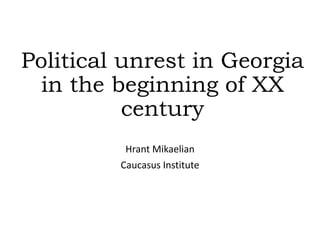Political unrest in Georgia in the beginning of XX century
- 1. Political unrest in Georgia in the beginning of XX century Hrant Mikaelian Caucasus Institute
- 2. During 1890-s, several political party prototype were established in Georgia.  Georgia's Freedom League (appealed to national and social issues, aimed to restore the independence of Georgia under favorable conditions, as the result of overthrow of the monarchy in Russia)  Mesame Dasi (left-wing, moderate nationalist literary group. Merged with RSDLP in 1903, formed Georgian Menshevik party. Claimed to be first Social Democrats in the Caucasus) Emergence of the political parties
- 3.  Georgian Bolshevik members of RSDLP (Radical left- wing, refused “narrow” national borders)  National Democrats (Nationalist ideology, autonomy claims, pro-German)  Armenian Revolutionary Federation (“Dashnak” party, nationalist and Socialist Revolutionary) Emergence of the political parties
- 4.  Social tensions, agrarian overpopulation  Inequality, poor conditions for labor workers  Georgian Orthodox autocephaly  Cultural and/ or political autonomy  Federalism/ Liberation from Russian Empire Agenda
- 5.  First known strike took place in 1872 by textile workers of Mirzoev’s mill  Until 1900, manifestations were rare  May Day demonstration of 1901 in Tbilisi claimed to have had 2000 participants, was broken up. 14 wounded, 30 arrested. Press did not report about the incident  The major area of labor strikes was Batumi (1902)  Khashuri strikes (1903) Protest movements in Georgia
- 6.  Were organized and manipulated by “Soso”, Joseph Jughashvili  Series of strikes were held during December, 1901 – June, 1902  Strikes at Mantashev’s, Rothschild's factories  During 9 March demonstrations, 15 were killed, dozens – wounded. Batumi strikes
- 7.  Mostly immigrant town, with predominance of temporary workers  By Jan. 1897, 5,942 people could be considered “proletariat”. Compare to 3,156 in Kutaisi  Male to female ratio: 250:100  Population 28,500 and fast growing  Most of workers were unskilled, temporary Batumi demographics
- 8.  Mostly immigrant town, with predominance of temporary workers  By Jan. 1897, 5,942 people could be considered “proletariat”. Compare to 3,156 in Kutaisi  Male to female ratio: 250  Population 28,500 and fast growing  Most of workers were unskilled, temporary Batumi demographics
- 10.  Became a repercussion of Batumi strikes  Peasants refused to pay taxes  Was organized by the former student Uratadze, who created a “secret semi-spiritual society”  Took 4 years (1902-1906)  The social relations were based on an utopist principles  Was in focus of Villari, Kollontay, Leo Tolstoy  Was an unique case of peasant republic governed by peasants themselves The Gurian movement
- 12.  Created own armed militia  Took control over railroad, Post office and Telegraph  Authorities were ignored  Some local noblemen were killed by the rebels  Local militia troops entered Ozurgeti at November, 1905 and declared a “Republic”  Had its own repercussions in the whole rural area of Georgia  The “Republic” was abandoned by Russian military The Gurian republic
- 14. Socio-Economic preconditions for the unrest
- 15. Socio-Economic preconditions for the unrest
- 16. Socio-Economic preconditions for the unrest
- 17. Socio-Economic preconditions for the unrest

















